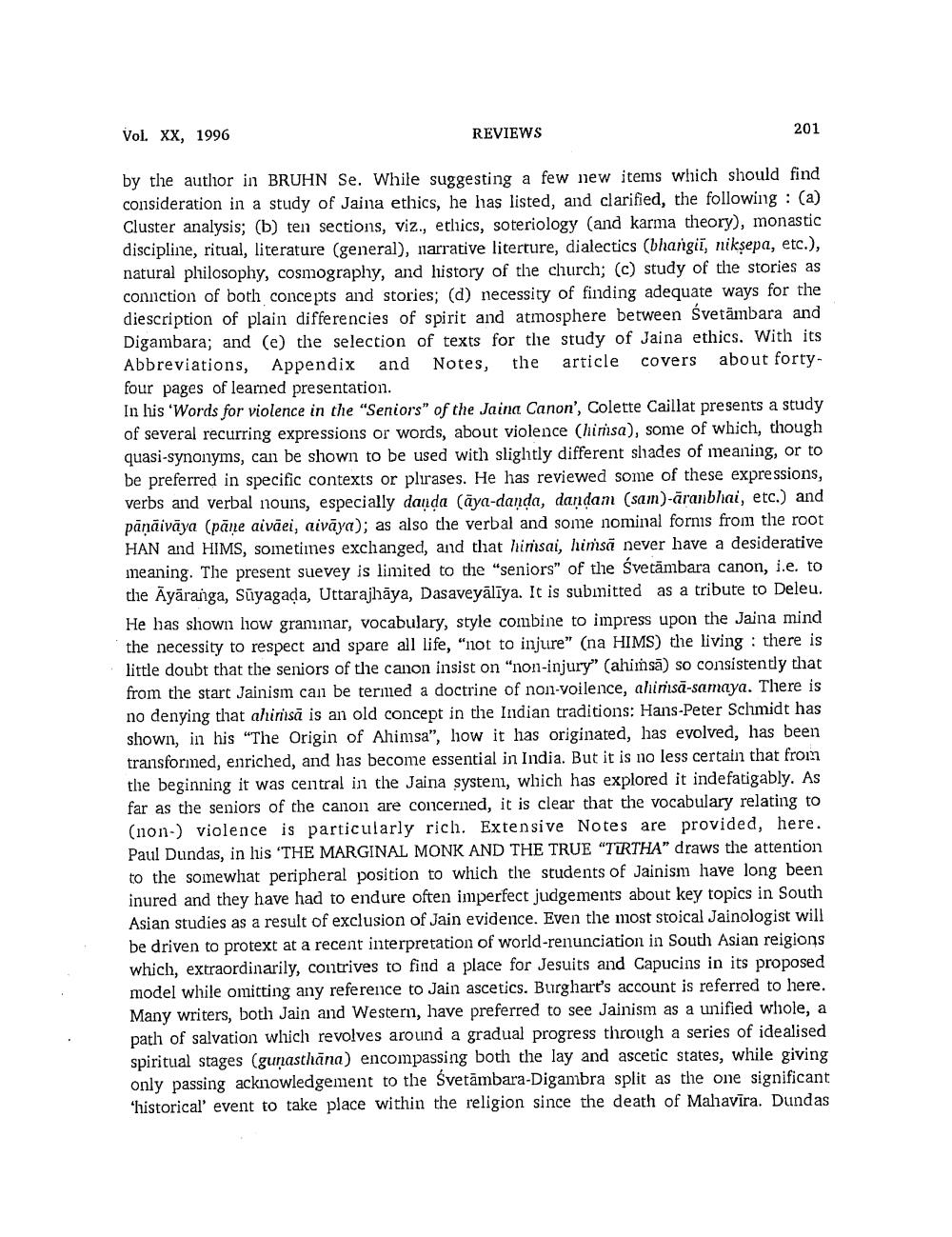________________
Vol. XX, 1996
REVIEWS
201
by the author in BRUHN Se. While suggesting a few new items which should find consideration in a study of Jaina ethics, he has listed, and clarified, the following: (a) Cluster analysis; (b) ten sections, viz., ethics, soteriology (and karma theory), monastic discipline, ritual, literature (general), narrative literture, dialectics (bhangiī, niksepa, etc.), natural philosophy, cosmography, and history of the church; (c) study of the stories as connction of both concepts and stories; (d) necessity of finding adequate ways for the diescription of plain differencies of spirit and atmosphere between Svetämbara and Digambara; and (e) the selection of texts for the study of Jaina ethics. With its Abbreviations, Appendix and Notes, the article covers about fortyfour pages of learned presentation. In his 'Words for violence in the "Seniors" of the Jaina Canon', Colette Caillat presents a study of several recurring expressions or words, about violence (hirsa), some of which, though quasi-synonyms, can be shown to be used with slightly different shades of meaning, or to be preferred in specific contexts or plirases. He has reviewed some of these expressions, verbs and verbal nouns, especially danda (āya-danda, dandam (sam)-āranbhai, etc.) and pāņāivāya (pāne aivāei, aivāya); as also the verbal and some nominal forns from the root HAN and HIMS, sometimes exchanged, and that hirsai, hinsä never have a desiderative meaning. The present suevey is limited to the "seniors" of the vetāmbara canon, i.e. to thie Āyāranga, Sūyagada, Uttarajhāya, Dasaveyālīya. It is submitted as a tribute to Deleu. He has shown low grammar, vocabulary, style combine to impress upon the Jaina mind the necessity to respect and spare all life, "not to injure" (na HIMS) the living there is little doubt that the seniors of the canon insist on "non-injury" (ahimsā) so consistently that from the start Jainism can be termed a doctrine of non-voilence, ahinsā-samaya. There is no denying that ahirisā is an old concept in the Indian traditions: Hans-Peter Schmidt has shown, in his "The Origin of Ahimsa", how it has originated, has evolved, has been transformed, enriched, and has become essential in India. But it is no less certain that from the beginning it was central in the Jaina system, which has explored it indefatigably. As far as the seniors of the canon are concerned, it is clear that the vocabulary relating to (non-) violence is particularly rich. Extensive Notes are provided, here. Paul Dundas, in his 'THE MARGINAL MONK AND THE TRUE "TTRTHA" draws the attention to the somewhat peripheral position to which the students of Jainism have long been inured and they have had to endure often imperfect judgements about key topics in South Asian studies as a result of exclusion of Jain evidence. Even the most stoical Jainologist will be driven to protext at a recent interpretation of world-renunciation in South Asian reigions which, extraordinarily, contrives to find a place for Jesuits and Capucins in its proposed model while omitting any reference to Jain ascetics. Burghart's account is referred to here. Many writers, both Jain and Western, have preferred to see Jainism as a unified whole, a path of salvation which revolves around a gradual progress through a series of idealised spiritual stages (gunasthāna) encompassing both the lay and ascetic states, while giving only passing acknowledgement to the Svetambara-Digambra split as the one significant 'historical event to take place within the religion since the death of Mahavīra. Dundas




